Abstract
The organic constituents of exhaled human breath are representative of bloodborne concentrations through gas exchange in the blood/breath interface in the lungs. The presence of specific compounds can be an indicator of recent exposure or represent a biological response of the subject. For volatile organic compounds, sampling and analysis of breath is preferred to direct measurement from blood samples because breath collection is noninvasive, potentially infectious waste is avoided, the sample supply is essentially limitless, and the measurement of gas-phase analytes is much simpler in a gas matrix rather than in a complex biological tissue such as blood. However, to assess the distribution of a contaminant in the body requires a reasonable estimate of the blood level. We have investigated the use of noninvasive breath measurements as a surrogate for blood measurements for (high) occupational levels of trichloroethene in a controlled exposure experiment. Subjects were placed in an exposure chamber for 24 hr; they were exposed to 100 parts per million by volume trichloroethene for the initial 4 hr and to purified air for the remaining 20 hr. Matched breath and blood samples were collected periodically during the experiment. We modeled the resulting concentration data with respect to their time course and assessed the blood/breath relationship during the exposure (uptake) period and during the postexposure (elimination) period. Estimates for peak blood levels, compartmental distribution, and time constants were calculated from breath data and compared to direct blood measurements to assess the validity of the breath measurement methodology. Blood/breath partition coefficients were studied during both uptake and elimination. At equilibrium conditions at the end of the exposure, we could predict actual blood levels using breath elimination curve calculations and a literature value partition coefficient with a mean ratio of calculated:measured of 0.98 and standard error (SE) = 0.12 across all subjects. blood/breath comparisons at equilibrium resulted in calculated in vivo partition coefficients with a mean of 10.8 and SE = 0.60 across all subjects and experiments and 9.69 with SE = 0.93 for elimination-only experiments. We found that about 78% of trichloroethene entering the body during inhalation exposure is metabolized, stored, or excreted through routes other than exhalation.
Full text
PDF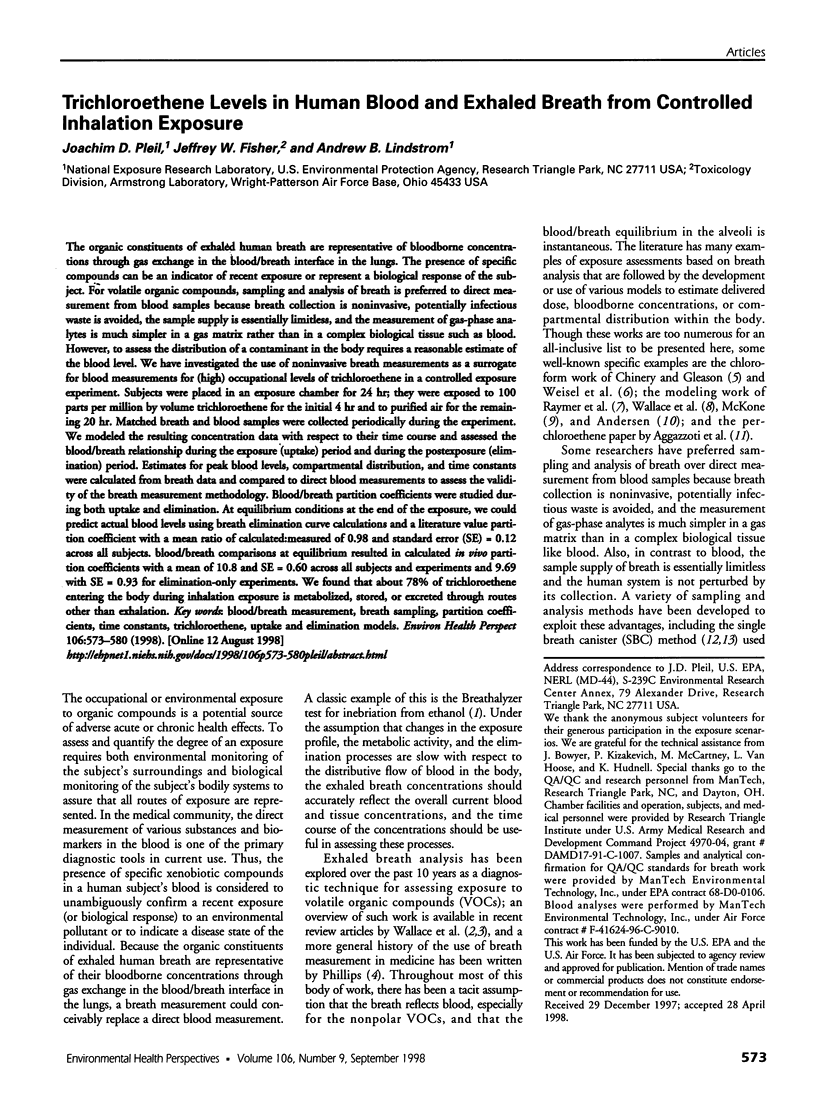
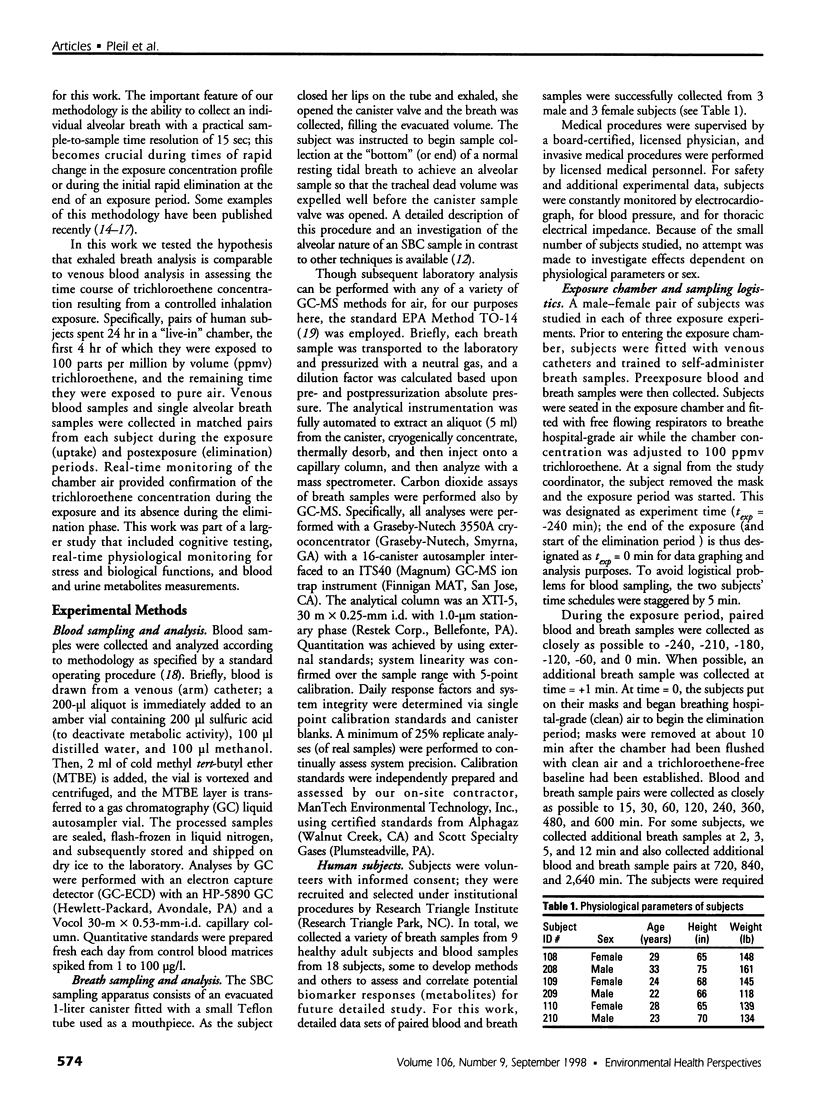
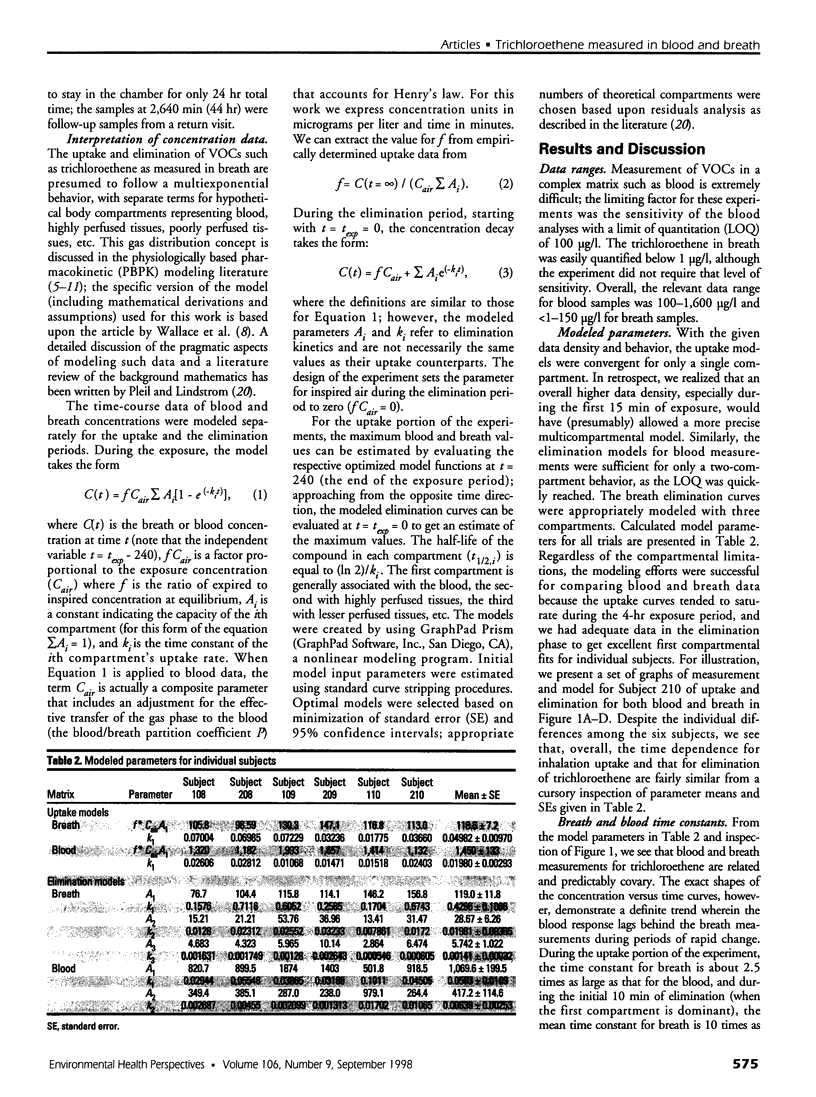
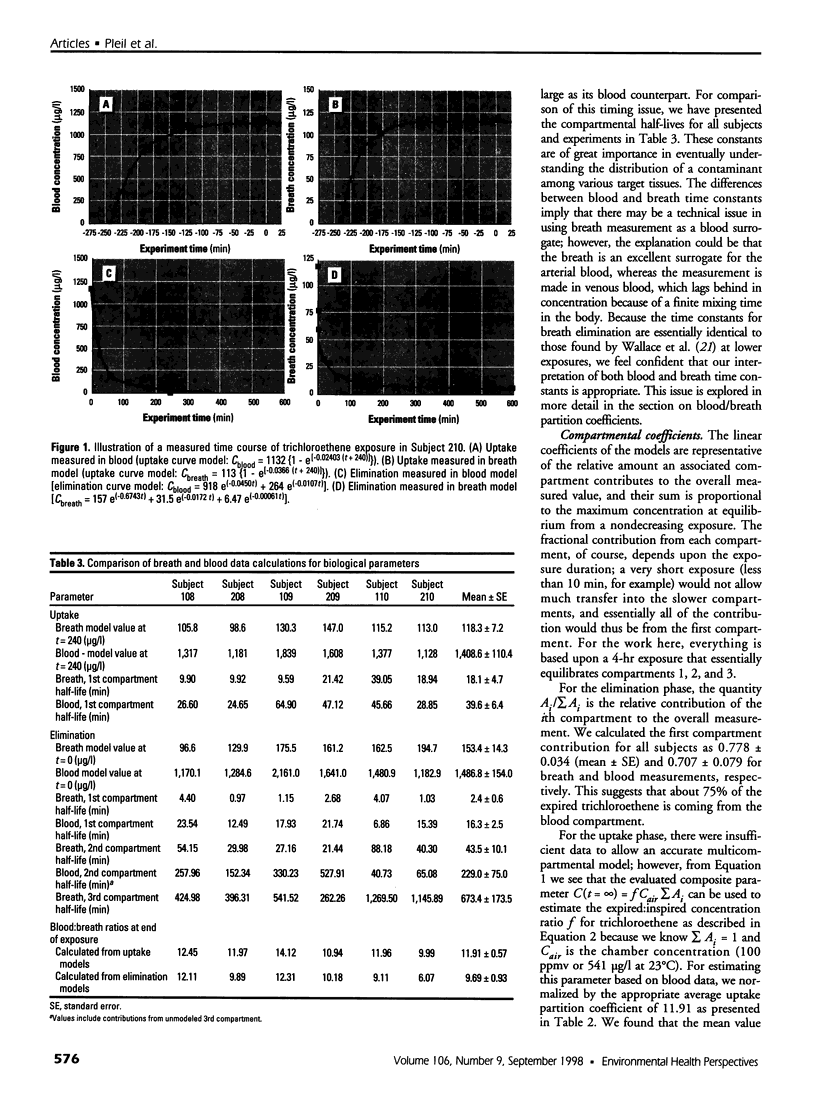
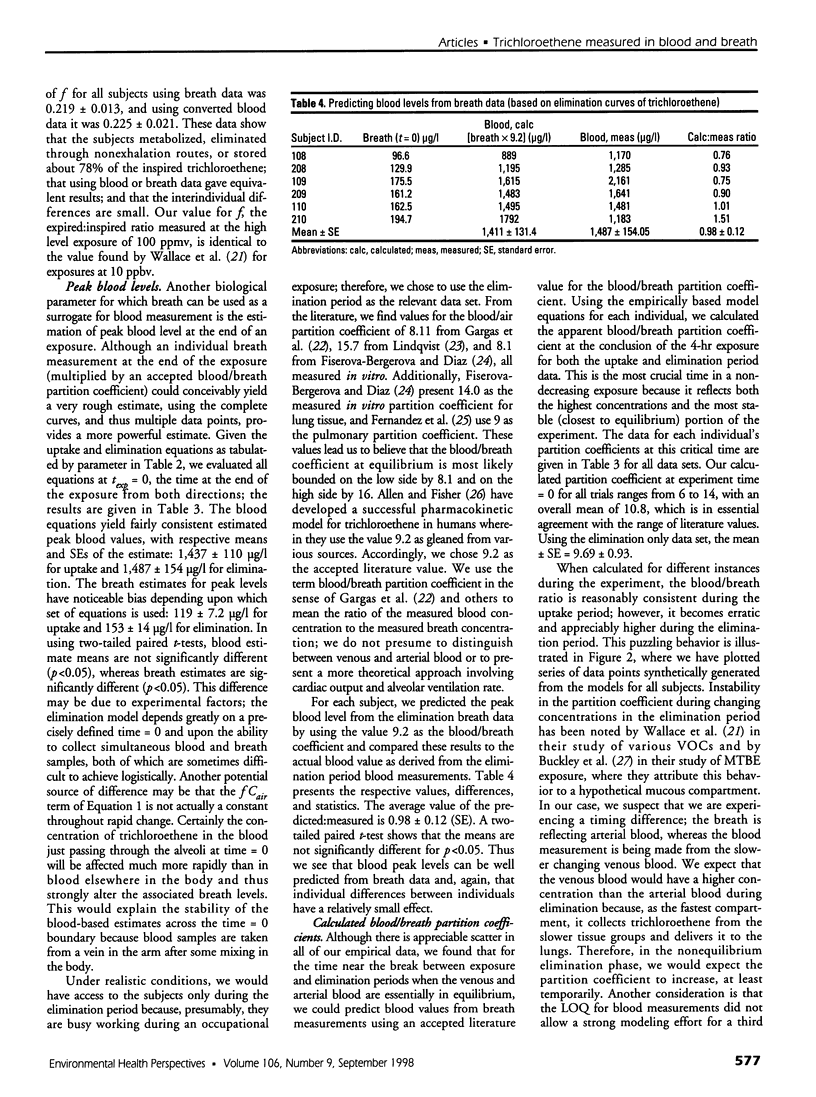
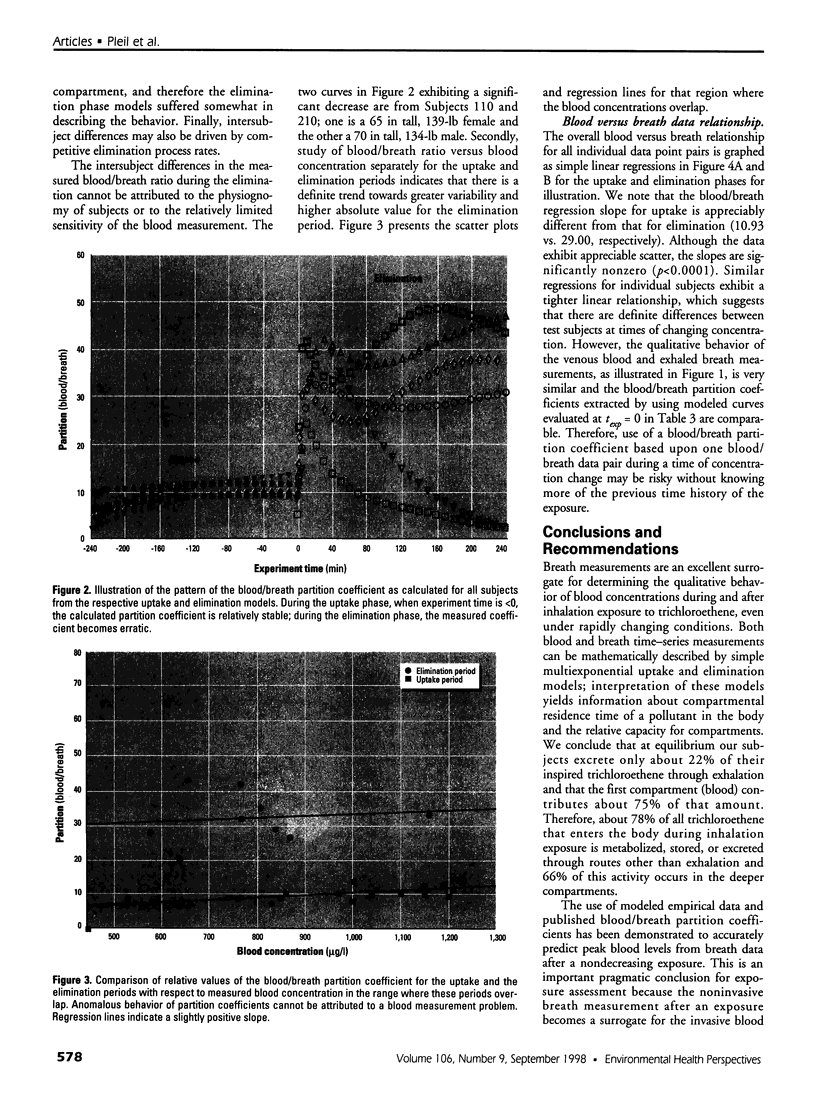
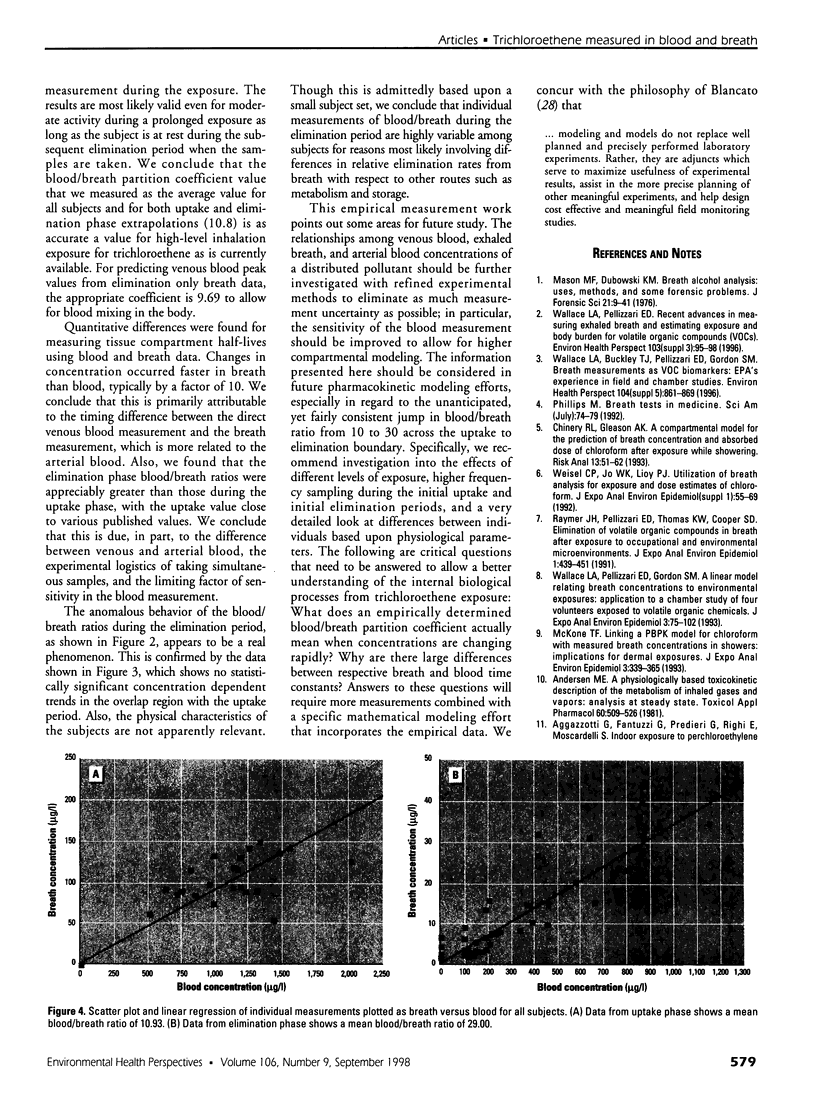
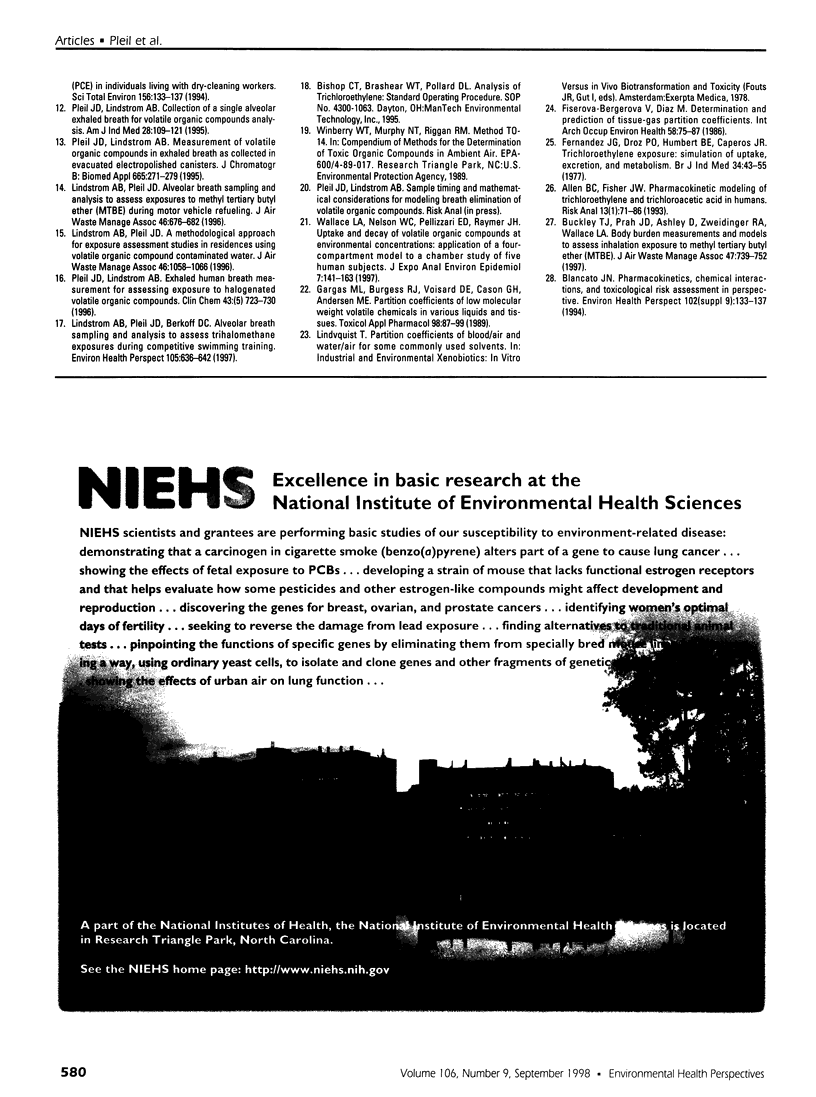
Images in this article
Selected References
These references are in PubMed. This may not be the complete list of references from this article.
- Allen B. C., Fisher J. W. Pharmacokinetic modeling of trichloroethylene and trichloroacetic acid in humans. Risk Anal. 1993 Feb;13(1):71–86. doi: 10.1111/j.1539-6924.1993.tb00730.x. [DOI] [PubMed] [Google Scholar]
- Andersen M. E. A physiologically based toxicokinetic description of the metabolism of inhaled gases and vapors: analysis at steady state. Toxicol Appl Pharmacol. 1981 Sep 30;60(3):509–526. doi: 10.1016/0041-008x(81)90338-0. [DOI] [PubMed] [Google Scholar]
- Blancato J. N. Pharmacokinetics, chemical interactions, and toxicological risk assessment in perspective. Environ Health Perspect. 1994 Nov;102 (Suppl 9):133–137. doi: 10.1289/ehp.94102s9133. [DOI] [PMC free article] [PubMed] [Google Scholar]
- Buckley T. J., Prah J. D., Ashley D., Zweidinger R. A., Wallace L. A. Body burden measurements and models to assess inhalation exposure to methyl tertiary butyl ether (MTBE). J Air Waste Manag Assoc. 1997 Jul;47(7):739–752. doi: 10.1080/10473289.1997.10463934. [DOI] [PubMed] [Google Scholar]
- Fernández J. G., Droz P. O., Humbert B. E., Caperos J. R. Trichloroethylene exposure. Simulation of uptake, excretion, and metabolism using a mathematical model. Br J Ind Med. 1977 Feb;34(1):43–55. doi: 10.1136/oem.34.1.43. [DOI] [PMC free article] [PubMed] [Google Scholar]
- Fiserova-Bergerova V., Diaz M. L. Determination and prediction of tissue-gas partition coefficients. Int Arch Occup Environ Health. 1986;58(1):75–87. doi: 10.1007/BF00378543. [DOI] [PubMed] [Google Scholar]
- Gargas M. L., Burgess R. J., Voisard D. E., Cason G. H., Andersen M. E. Partition coefficients of low-molecular-weight volatile chemicals in various liquids and tissues. Toxicol Appl Pharmacol. 1989 Mar 15;98(1):87–99. doi: 10.1016/0041-008x(89)90137-3. [DOI] [PubMed] [Google Scholar]
- Lindstrom A. B., Pleil J. D. A methodological approach for exposure assessment studies in residences using volatile organic compound-contaminated water. J Air Waste Manag Assoc. 1996 Nov;46(11):1058–1066. [PubMed] [Google Scholar]
- Lindstrom A. B., Pleil J. D. Alveolar breath sampling and analysis to assess exposures to methyl tertiary butyl ether (MTBE) during motor vehicle refueling. J Air Waste Manag Assoc. 1996 Jul;46:676–682. doi: 10.1080/10473289.1996.10467502. [DOI] [PubMed] [Google Scholar]
- Lindstrom A. B., Pleil J. D., Berkoff D. C. Alveolar breath sampling and analysis to assess trihalomethane exposures during competitive swimming training. Environ Health Perspect. 1997 Jun;105(6):636–642. doi: 10.1289/ehp.97105636. [DOI] [PMC free article] [PubMed] [Google Scholar]
- Mason M. F., Dubowski K. M. Breath-alcohol analysis: uses, methods, and some forensic problems--review and opinion. J Forensic Sci. 1976 Jan;21(1):9–41. [PubMed] [Google Scholar]
- McKone T. E. Linking a PBPK model for chloroform with measured breath concentrations in showers: implications for dermal exposure models. J Expo Anal Environ Epidemiol. 1993 Jul-Sep;3(3):339–365. [PubMed] [Google Scholar]
- Pleil J. D., Lindstrom A. B. Collection of a single alveolar exhaled breath for volatile organic compounds analysis. Am J Ind Med. 1995 Jul;28(1):109–121. doi: 10.1002/ajim.4700280110. [DOI] [PubMed] [Google Scholar]
- Pleil J. D., Lindstrom A. B. Exhaled human breath measurement method for assessing exposure to halogenated volatile organic compounds. Clin Chem. 1997 May;43(5):723–730. [PubMed] [Google Scholar]
- Pleil J. D., Lindstrom A. B. Measurement of volatile organic compounds in exhaled breath as collected in evacuated electropolished canisters. J Chromatogr B Biomed Appl. 1995 Mar 24;665(2):271–279. doi: 10.1016/0378-4347(94)00545-g. [DOI] [PubMed] [Google Scholar]
- Raymer J. H., Pellizzari E. D., Thomas K. W., Cooper S. D. Elimination of volatile organic compounds in breath after exposure to occupational and environmental microenvironments. J Expo Anal Environ Epidemiol. 1991 Oct;1(4):439–451. [PubMed] [Google Scholar]
- Wallace L. A., Nelson W. C., Pellizzari E. D., Raymer J. H. Uptake and decay of volatile organic compounds at environmental concentrations: application of a four-compartment model to a chamber study of five human subjects. J Expo Anal Environ Epidemiol. 1997 Apr-Jun;7(2):141–163. [PubMed] [Google Scholar]
- Wallace L. A., Pellizzari E. D. Recent advances in measuring exhaled breath and estimating exposure and body burden for volatile organic compounds (VOCs). Environ Health Perspect. 1995 Apr;103 (Suppl 3):95–98. doi: 10.1289/ehp.95103s395. [DOI] [PMC free article] [PubMed] [Google Scholar]
- Wallace L., Buckley T., Pellizzari E., Gordon S. Breath measurements as volatile organic compound biomarkers. Environ Health Perspect. 1996 Oct;104 (Suppl 5):861–869. doi: 10.1289/ehp.96104s5861. [DOI] [PMC free article] [PubMed] [Google Scholar]
- Wallace L., Pellizzari E., Gordon S. A linear model relating breath concentrations to environmental exposures: application to a chamber study of four volunteers exposed to volatile organic chemicals. J Expo Anal Environ Epidemiol. 1993 Jan-Mar;3(1):75–102. [PubMed] [Google Scholar]






